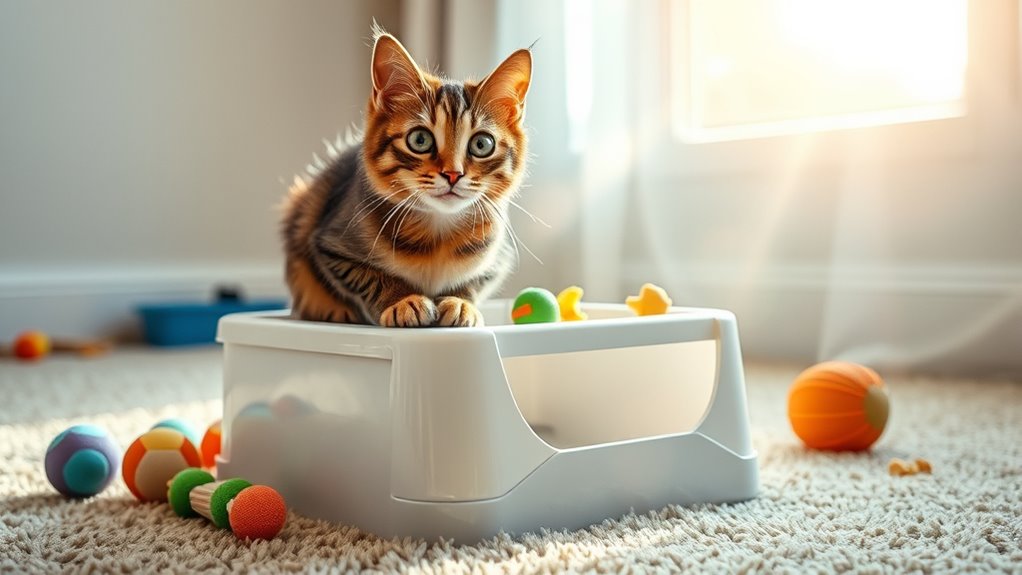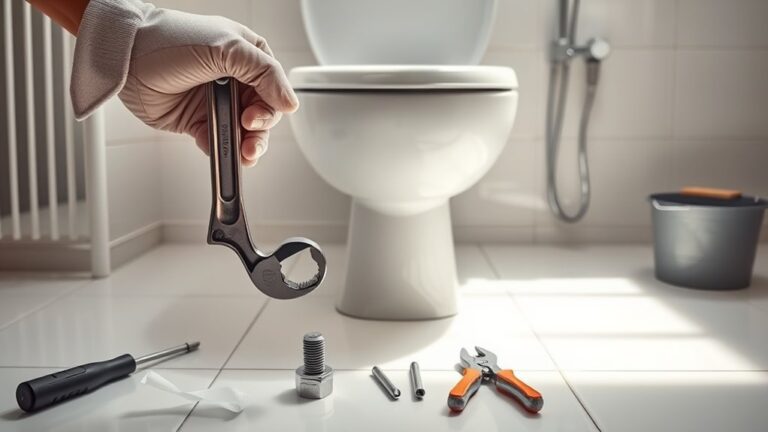If your cat’s pooping on the floor, first rule out health issues with a vet to verify there’s no medical cause. Then, check your litter box setup: keep it clean, in a quiet spot, and use litter your cat prefers. Reduce stress by providing safe spaces and limit access to problem areas. Reward your cat for using the box, and clean accidents thoroughly with enzyme cleaners to remove odors. There are more strategies to help you manage this behavior effectively.
Identify Possible Health Issues
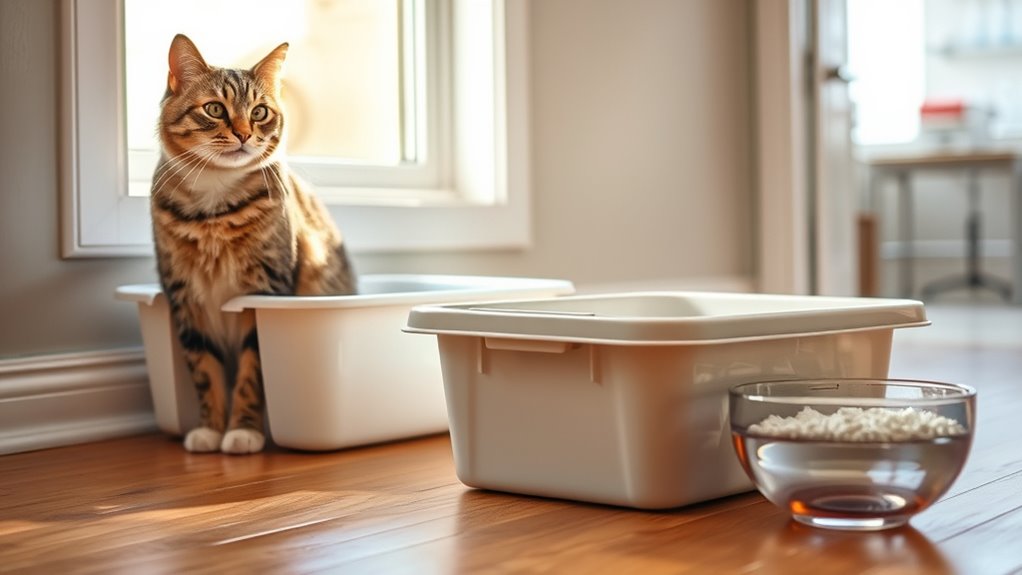
Before addressing behavioral reasons for your cat’s inappropriate pooping, it’s important to rule out any health issues that might be causing this behavior. You should begin with careful symptom observation, noting any changes in your cat’s bowel movements, appetite, or activity levels. These signs can give you valuable clues. A thorough health assessment by your veterinarian is vital to identify conditions like infections, gastrointestinal problems, or urinary tract issues that often lead to accidents outside the litter box. Addressing medical causes early not only improves your cat’s well-being but also helps restore your freedom from constant cleanup. By prioritizing health, you guarantee your cat is comfortable and any behavioral adjustments you make later are built on a solid foundation of wellness.
Evaluate Your Cat’s Litter Box Setup
You’ll want to check where your cat’s litter box is placed, as a quiet, accessible spot can make a big difference. Also, consider the type of litter you’re using—some cats prefer certain textures or scents over others. Adjusting these factors can help encourage your cat to use the box consistently.
Litter Box Location
One essential factor to examine when your cat is pooping outside the litter box is the location of the litter box itself. Proper litter box placement plays a critical role in your cat’s comfort and willingness to use it consistently. Cats prefer quiet, low-traffic areas where they feel safe and undisturbed. Avoid placing the litter box near noisy appliances, busy doorways, or areas with strong odors. Environmental factors like accessibility and privacy are just as important; your cat should be able to reach the box easily without obstacles or stressors. By thoughtfully evaluating and adjusting the litter box location, you create a more inviting environment that respects your cat’s natural instincts, helping to reduce accidents and support their freedom to choose appropriate bathroom spots.
Litter Type Choice
The type of litter you choose can greatly impact your cat’s willingness to use the box consistently. When evaluating your cat’s litter box setup, consider the differences between clumping vs non clumping litters. Clumping litter makes cleaning easier and helps control odors, which can encourage your cat to use the box regularly. On the other hand, some cats prefer non clumping for its texture. Additionally, deciding between scented vs unscented litter is vital. While scented options may seem fresher to you, many cats find strong fragrances off-putting, leading to avoidance. Opting for unscented, natural litters often promotes comfort and freedom in your cat’s choice to use the box. Paying attention to these details respects your cat’s preferences and helps prevent floor accidents.
Maintain a Clean Litter Box
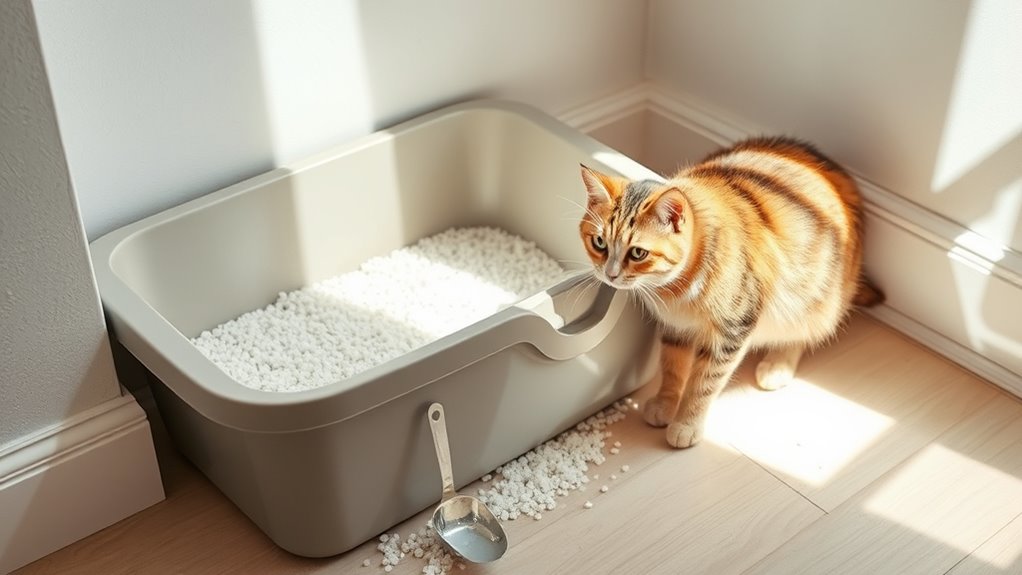
A clean litter box is essential to encourage your cat to use it consistently. Proper litter box maintenance not only supports your cat’s hygiene but also prevents unwanted floor pooping. You should scoop waste daily and fully clean the box with mild soap weekly. Maintaining this cleaning frequency keeps odors at bay and creates a comfortable environment for your cat. If the box is dirty, your cat may seek cleaner spots, like your floor, to relieve itself. Consistency in litter box upkeep respects your cat’s natural instincts and promotes freedom for both of you—freedom from accidents and stress. By committing to regular cleaning, you help your cat feel secure and confident in its designated space, reducing the chances of inappropriate elimination.
Choose the Right Type of Litter
Keeping the litter box spotless is just part of the solution; choosing the right type of litter can make a big difference in encouraging your cat to use it consistently. You’ll want to explore various litter material options, such as clumping clay, silica gel, recycled paper, or natural wood pellets. Each has unique textures and absorption capabilities, so pay attention to what your cat prefers. Scent preferences also matter—some cats dislike strong fragrances, which can deter them from using the box. Opt for unscented or lightly scented litters if you’re unsure. By selecting the right litter that suits your cat’s comfort and habits, you’re fostering an environment that supports their natural behaviors and helps free both of you from the frustration of accidents on the floor.
Address Stress and Anxiety in Your Cat
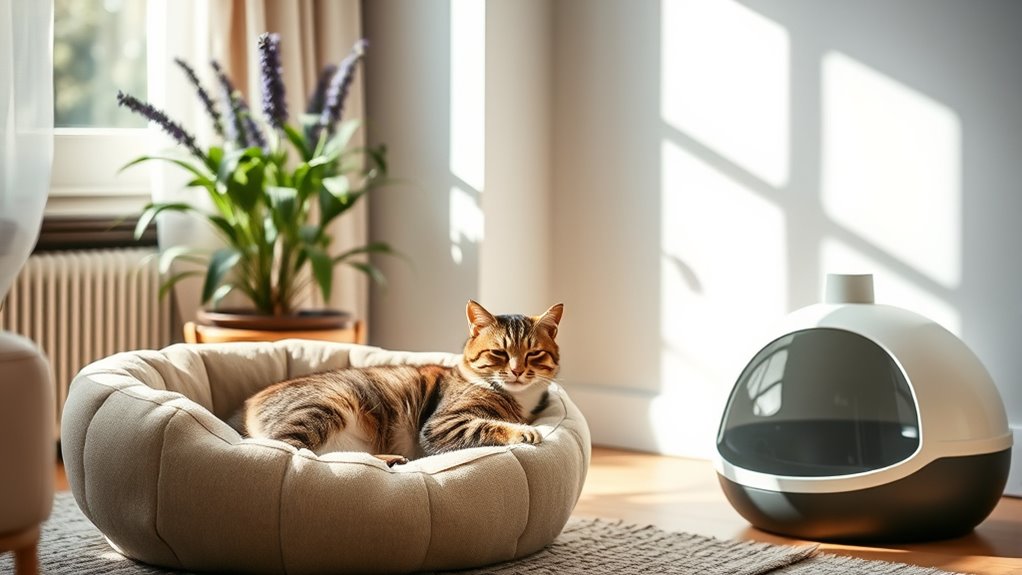
If your cat is pooping on the floor, it might be reacting to stress or anxiety. You’ll want to observe what triggers these feelings and create safe, quiet spaces where your cat feels secure. Addressing these emotional needs can help encourage proper litter box use.
Recognize Anxiety Triggers
Because cats are highly sensitive to changes in their environment, identifying what triggers their anxiety is essential in stopping unwanted behaviors like pooping on the floor. Environmental changes such as moving furniture, new pets, or even loud noises can unsettle your cat. Social dynamics also play an important role; the introduction of new family members or other animals may disrupt their sense of security. You’ll want to observe your cat’s behavior closely to spot patterns or stress signals like hiding or excessive grooming. By recognizing these anxiety triggers early, you can take steps to minimize their impact. Doing so promotes a calmer, more confident cat, which is key to preventing accidents and ensuring both your freedom and your pet’s well-being.
Provide Safe Spaces
While anxiety triggers can be challenging to control, you can substantially reduce your cat’s stress by providing safe, quiet spaces where they feel secure. Creating designated safe zones in your home allows your cat to retreat when overwhelmed, fostering a sense of control and freedom. These comforting environments might include cozy beds, secluded corners, or elevated perches away from noise and activity. Make certain these areas are consistently accessible and free from disturbances. By offering your cat such safe zones, you help alleviate anxiety, which often contributes to inappropriate pooping. Remember, a calm, confident cat is less likely to exhibit stress-related behaviors. Prioritize these comforting environments as part of your strategy to support your cat’s emotional well-being and encourage proper litter box use.
Limit Access to Problem Areas
One effective way to prevent your cat from pooping on the floor is to limit their access to the problem areas. You can use furniture barriers to block off spots where your cat tends to eliminate, creating a physical boundary that discourages unwanted behavior. Additionally, implementing room restrictions by closing doors or using baby gates helps control where your cat can roam, reducing the chance of accidents. This approach respects your cat’s freedom while guiding them toward appropriate elimination areas. Remember, limiting access is a temporary measure to support retraining, not a permanent confinement. By managing your cat’s environment thoughtfully, you create clear boundaries that encourage better habits without causing stress or frustration for either of you.
Use Enzyme Cleaners to Remove Odors
If your cat has soiled the floor, simply cleaning the area with regular household products won’t be enough to prevent repeat accidents. You need to tackle the problem at its source by using enzyme cleaners designed specifically for pet messes. These cleaners break down organic matter, which means their enzyme effectiveness goes beyond masking odors—they eliminate them completely. When the scent is gone, your cat won’t be drawn back to the same spot, allowing you to regain control over your space. Choosing a high-quality enzyme cleaner guarantees thorough odor removal, making your home fresher and discouraging your cat from repeating the behavior. By addressing lingering smells properly, you’re giving both yourself and your cat the freedom to enjoy a cleaner, more comfortable environment.
Provide Positive Reinforcement for Proper Behavior
Positive reinforcement is a powerful tool to encourage your cat to use the litter box consistently. By establishing clear reward systems, you can motivate your cat to repeat the proper behavior without feeling pressured or restricted. Whenever your cat uses the litter box correctly, immediately offer praise, affection, or a small treat. This positive reinforcement helps your cat associate the litter box with pleasant experiences, making it more likely to return there. Consistency is key—reward every successful attempt to strengthen the habit. Avoid punishing accidents, as this can cause anxiety and worsen the problem. Instead, focus on celebrating progress, creating an environment where your cat feels safe and free to develop good habits naturally through encouragement and rewards.
Consult a Veterinarian or Animal Behaviorist
While rewarding your cat for using the litter box can be very effective, sometimes underlying health or behavioral issues may be causing the unwanted floor accidents. In such cases, seeking a veterinary consultation or behavioral assessment is essential. A professional can identify medical conditions or stressors affecting your cat’s habits and recommend tailored solutions, helping both you and your cat regain freedom from this frustration.
| Professional Help | Purpose | Expected Outcome |
|---|---|---|
| Veterinary Consultation | Rule out medical issues | Accurate diagnosis and treatment |
| Behavioral Assessment | Identify stress/triggers | Customized behavior plan |
| Combined Approach | Address all factors | Improved litter box use |
| Follow-up Support | Monitor progress | Long-term success and freedom |

